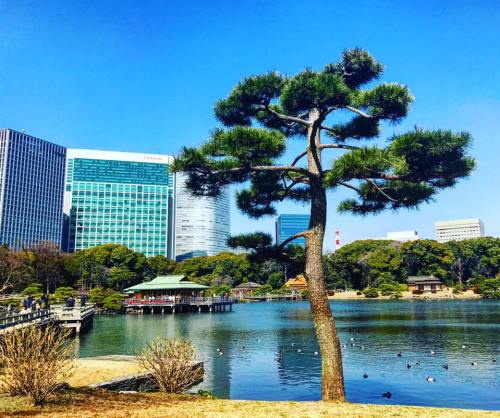Hamarikyu Gardens, Chuo-ku
Located at the mouth of the Sumida River. It was opened April 1, 1946 and was remodeled as a public garden park on the site of a villa of the Shogun Tokugawa family in the 17th century.



 Taken by Orzugul Babakhodjaeva
Taken by Orzugul Babakhodjaeva




 Taken by Ana Kontic
Taken by Ana Kontic 
 Taken by Jelena Jeremic
Taken by Jelena Jeremic
Sankei-en, Yokohama
A traditional Japanese-style garden which opened in 1906. Sankei-en was designed and built by Sankei Hara, who was a silk trader.



 Taken on December 2, 2017 by Masami Nagase
Taken on December 2, 2017 by Masami Nagase
Rikugien Garden, Bunkyo-ku
Rikugi (六義) means the Six Principles of Poetry which comes from the idea of the six elements in waka (和歌, a type of poetry in classical Japanese literature).
Higo-Hosokawa Garden, Bunkyo-ku
Formerly the second home of Hosokawa, one of Japanese samurai kin groups and the head of the Kumamoto (Higo) domain, at the end of the Edo Period, the premises later became the main residence of the Hosokawa family.




 Kumamoto bamboo lanterns produced by CHIKAKEN
Kumamoto bamboo lanterns produced by CHIKAKEN
Happo-en Garden, Minato-ku
It was built in the early 17th century. In 1915, the industrialist Fusanosuke Kuhara remodeled the garden and built most of today’s buildings. It serves mainly as a backdrop for traditional Japanese wedding parties and banquets.
Shinjuku Gyoen National Garden, Shinjuku-ku/Shibuya-ku
It was originally a residence of the Naito family in the Edo period. Afterwards, it became a garden under the management of the Imperial Household Agency of Japan.



 Taken by Isao Tokuhashi
Taken by Isao Tokuhashi
 Taken by Hai Trieu
Taken by Hai Trieu
Kiyosumi Garden, Koto-ku
It’s said to be the site of the residence of Kinokuniya Bunzaemon, the famous Edo era business magnate. In 1878, Iwasaki Yataro, the founder of Mitsubishi, acquired the land for use as a garden, and it opened as a garden in 1880 under the name of “Fukagawa Shimbokuen.”
Chinzan-so, Bunkyo-ku
Founded in 1878, the garden is rich in historic remains and artifacts. The garden is part of the Hotel Chinzanso Tokyo property.
 Night view of the garden. *Taken by Ayami Ito
Night view of the garden. *Taken by Ayami Ito
Meiji Jingu Shrine Iris Garden, Shibuya-ku
Mejiro Garden, Toshima-ku
 Taken by Chi-Fen Wu
Taken by Chi-Fen Wu
Denpoin Gardens, Taito-ku
Located behind the Five-story Pagoda within the precinct of Senso-ji Temple. It’s exceptionally open to the public from March 25 until April 28.

 *Taken by K2-Style
*Taken by K2-Style






















































